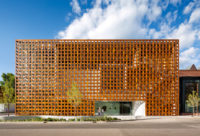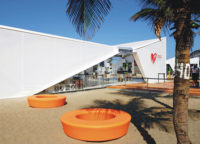Moveable Floating Galleries Bring a Burst of Color to Shigeru Ban’s Simose Art Museum
.jpg?1692184429)
Architects & Firms
Riffing on the traditional shoji screen, Shigeru Ban adores architecture with moving parts. Among other things, the Pritzker Prize–winning Japanese architect has created rooms that roll, facades that retract like garage doors, and sail-shaped solar panels that rotate. Pushing that concept in a new direction, his Simose Museum in Hiroshima Prefecture features eight floating galleries, each one a different color. Inspired by the small islands dotting the Seto Inland Sea in front of the site, they can be unmoored and repositioned, enabling not just the rearrangement of the art but of the building itself.

A mirrored glass wall running along the side of the museum's fixed gallery space reflects the surrounding landscape. Photo © Hiroyuki Hirai
The project, which opened in March, began with a direct commission from the president of Marui Sangyo Corporation, a producer of construction equipment, who wanted to build a small museum for her family’s art collection. Their holdings include traditional hina ningyo dolls, Japanese and Western paintings, plus glass and furniture by the French artist and designer Émile Gallé. Though the initial plan was to locate the museum near the company’s Hiroshima headquarters, a zoning matter required a site change. This led to the acquisition of a 1,312-foot-long strip of land with a spectacular seaside view. “The opportunity to build on such a big property facing the ocean is very unusual in Japan,” notes Ban. The one catch was accessibility to the site by the general public.

The museum’s entrance hall features a laminated timber ceiling and Ban’s signature tree-like columns. Photo © Hiroyuki Hirai
Though within easy reach of the Shinkansen bullet train station or Iwakuni Kintaikyo Airport, the site is an hour’s drive from the city of Hiroshima. To encourage visitors, as well as take advantage of the museum campus’s expansive size, Ban enlarged the scope of work by adding ten rental villas (four are versions of his earlier residential designs) and a French restaurant. The complex begins with an oval entry pavilion containing the museum’s information desk, café, shop, and restrooms. It is capped with a laminated timber ceiling supported by two tree-shaped columns—the expression of structure is the dominant visual feature of many of Ban’s buildings. At the roof perimeter, slender steel columns double as mullions for full-height glass walls. From here, a path in one direction goes to the villas and the restaurant while a glazed corridor in the other connects to the galleries: eight floating rooms on one side and a fixed one on the other. While the colorful boxes enliven the complex, the fixed gallery is hidden by a mirrored glass wall reflecting the landscape and an earth-covered roof that serves as a viewing platform. It looks out at the sea and islands which fan out beyond the colored galleries directly in front. At ground level, the flower-studded Émile Gallé Garden, a tranquil space inspired by the artist’s palette, stands off to one side.

1

2

3
The museum’s French restaurant (1); the exterior (2) and interior (3) of the Kielsteg House, one of ten Ban-designed luxury rental accommodations on the museum grounds. Photos © Hiroyuki Hirai
Gallé’s palette also inspired the eight hues that Ban selected for the floating galleries. Utilizing existing technology in a novel way—another signature of Ban’s work—the gallery bases were built from platform barges. As the area around the museum is a center of the Japanese shipping industry, they were constructed locally, tugged across the water to the site, and then lifted by crane into the 65,000-square-foot, 6-inch-deep pond that contains the floating galleries. Each platform is anchored to the pond bottom and attaches to a steel frame securing the colored glass walls and roof. Sandwiched between these exterior surfaces and the drywall interior is a layer of lighting that bathes each box in a colorful glow. Bridges spanning the individual rooms enable movement from one gallery to the next.
While the boxes could be configured in countless variations, only seven have been approved for compliance with government egress and safety regulations. Requiring three weeks to complete, rearranging the boxes is a multi-step process that includes raising the pond’s depth to nearly two feet by filling it with tap water and rain stored in underground cisterns, disconnecting and re-connecting the bridges as well as the electricity, and pulling the boxes into place. Though each floating structure weighs 42.5 tonnes, they can be maneuvered with just two people.

4

5
The reception area for the rental villas (4); view of the floating galleries (5). Photos © Hiroyuki Hirai
While realizing the floating galleries challenged construction conventions, the most trying task was building ten different villas at the same time since their designs, structural systems, and detailing all differed. “This was more difficult than the museum,” recalls Ban. Even the four replicas of pre-existing Ban houses had to be modified from their original designs since they were being recast as luxury rental accommodations. But these efforts allow visitors to interact not just with the client’s art but also Ban’s architecture.
At the Shigeru Ban–designed Simose Museum in Japan, workers position one of eight reconfigurable floating galleries within a shallow artificial pond. Courtesy Shigeru Ban Architects.



